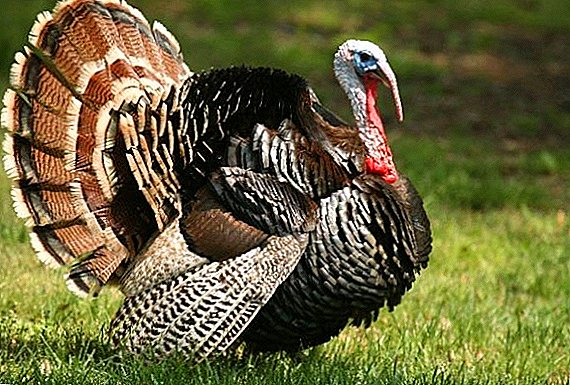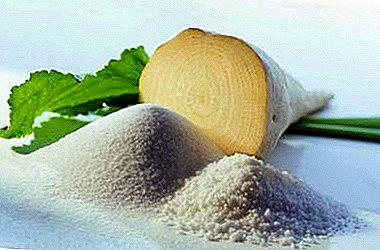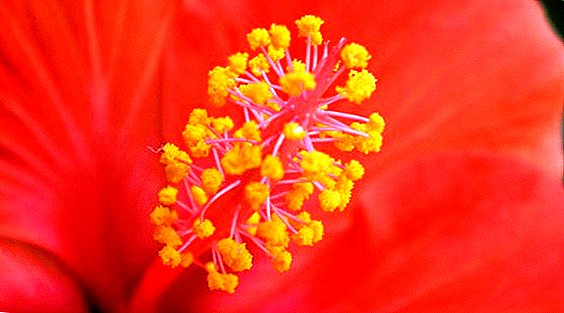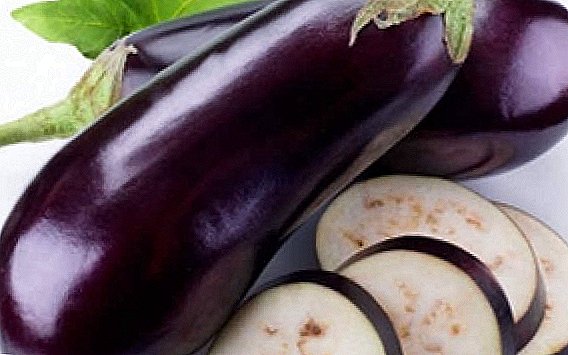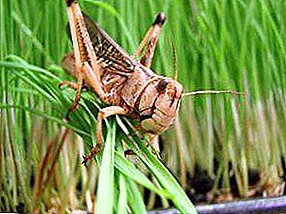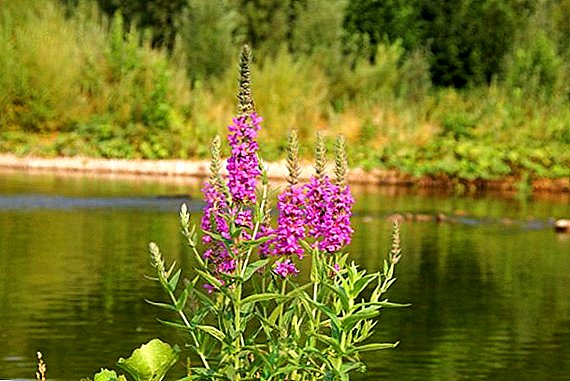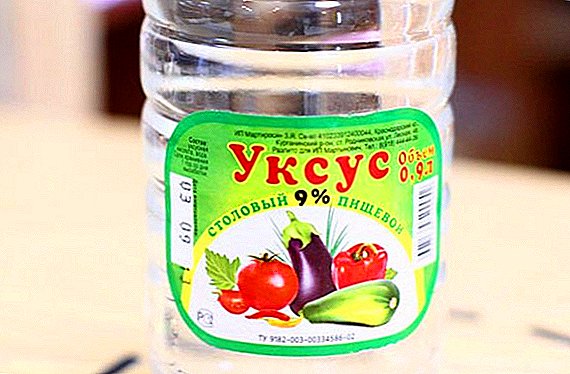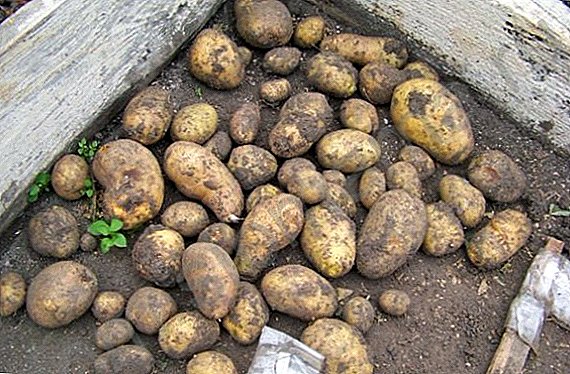 Modern and high-quality varieties of potatoes are the main condition for the collection of high yields of culture, regardless of the climatic characteristics of the region. One of these vegetable species is the Farmer potato variety. It gives a rich harvest, and is also able to surprise everyone with its taste characteristics. However, despite its popularity and demand in the market, this culture remains unknown to many. Therefore, today we will examine in detail what the variety “Farmer” is, and also reveal its advantages and disadvantages.
Modern and high-quality varieties of potatoes are the main condition for the collection of high yields of culture, regardless of the climatic characteristics of the region. One of these vegetable species is the Farmer potato variety. It gives a rich harvest, and is also able to surprise everyone with its taste characteristics. However, despite its popularity and demand in the market, this culture remains unknown to many. Therefore, today we will examine in detail what the variety “Farmer” is, and also reveal its advantages and disadvantages.
Selection
Potato "Farmer" is a unique crop. Despite the fact that this plant is widely used by growers and large farms, almost nothing is known about the history of its creation. This variety is not included in the register of fruit crops of any country, and is not recognized by most breeding schools.
The cultivation of the variety occurred naturally with the participation of both individual farmers and small farms over the years. Today, the Farmer has persistent characteristics that distinguish it from other varieties of potatoes, but the product of the “nationwide selection” is still unrecognized.
Did you know? The introduction of potatoes in food occurred in the territory of modern Bolivia about 9 thousand years ago. Thus, this vegetable is one of the most ancient cultivated plants grown by man.
Botanical description
"Farmer" refers to typical potato varieties that are actively cultivated in temperate climates. Therefore, the plant is characterized by an average length of shoots and low expressiveness relative to other cultures. But despite this, the plant has unique features, the combination of which determines its main distinguishing features.
But despite this, the plant has unique features, the combination of which determines its main distinguishing features.
Check out the super early, early and mid-early potato varieties.
Tubers
Tubers of a plant are characterized by the following botanical features:
- size - medium, fruits of the same type;
- shape - oval, elongated, tubers look neat and balanced;
- peephole type - small, superficial;
- peephole color - no staining;
- skin type - thin, smooth;
- the color of the peel and pulp is monochromatic, light yellow shades prevail;
- average weight - 90-110 g;
- the amount of starch in 100 g - 10-12 g;
- culinary qualities - potatoes are suitable for cooking boiled and fried dishes; when slicing and heat processing the tubers do not fall apart, they also retain the color of the pulp.

We recommend to get acquainted with the technology of growing potatoes under straw and in bags.
Bushes
Plant bushes are characterized by the following botanical features:
- bush size - medium;
- stem type - intermediate, upright, forms non-sprawling branches;
- green mass formation activity is medium;
- leaflets are medium-sized, of medium size, they are characterized by a weak waviness of the edge and clearly traced veins;
- leaf color - bright green;
- corolla - compact, assembled from several large flowers;
- flower color - white;
- berries - small and few;
Characteristic variety
Despite the lack of a professional selection approach in the breeding of this variety, the “national breeders” managed to create a truly high-quality product. "Farmer" has all the necessary qualities in order to compete with the majority of domestic and foreign varieties. Besides, This potato is one of the few fruit plants that are resistant to degeneration for 5-6 years. 
Disease resistance
Farmer is highly resistant to many potato diseases found in the northern hemisphere. This plant is highly resistant to the following ailments:
- potato cancer;
- late blight tops;
- late blight tuber;
- nematodoses
However, in order to obtain high and high-quality yields, the green mass of potatoes must be processed against the Colorado potato beetle and aphid.
Terms of ripening
"Farmer" is characterized by early ripening. Tubers are ready to harvest in 50-60 days after planting. Under particularly favorable conditions, as well as in a zone with a tropical or subtropical climate, the tubers mature 40–45 days after planting.
Important! Tightening the harvest of potato varieties "Farmer" is not worth it, a long stay of ripened tubers in the ground can cause them to get a blight.

The early ripe potato varieties also include: “Queen Anne”, “Veneta”, “Bellaroza”, “Zhukovsky Early”, “Rosara”, “Gala”.
Yield
Potatoes have high yields, about 1–25 tons of potatoes can be harvested from 1 hectare of plantings. This means that a single plant can form at least 10-15 tubers. In addition, the Farmer variety has a fairly high commercial quality, since the percentage of substandard tubers after harvest is minimal, regardless of the climatic conditions and the growing region.
Recumbency
Harvest "Farmer" has a high keeping quality (90-95%). Tubers are perfectly stored at a temperature of + 2-3 ° С for many months, while the storage room for the harvest must be periodically ventilated to avoid excessive moisture.
Growing regions
Potato "Farmer" grows well and bears fruit in both northern and temperate, and tropical climates. Plants are able to actively grow and develop even at a temperature of about + 10-15 ° C, however, the richest and highest-quality yields are observed in regions with a warm and mild climate, with a minimum number of sharp changes in seasonal temperatures.
Growing seedlings from potato seeds
In most cases, the active cultivation of potatoes involves the cultivation of the crop by planting seed tubers. This agricultural technique makes it possible to obtain high-quality potatoes for many years.  However, in order to achieve the highest possible yields on an ongoing basis, it will not be possible to manage without growing seed seedlings. Only reproduction by seeds is able to provide the plants with the necessary exchange of genetic material, which completely excludes the degeneration of the variety. Therefore, below we consider all the main subtleties and features of this process.
However, in order to achieve the highest possible yields on an ongoing basis, it will not be possible to manage without growing seed seedlings. Only reproduction by seeds is able to provide the plants with the necessary exchange of genetic material, which completely excludes the degeneration of the variety. Therefore, below we consider all the main subtleties and features of this process.
Optimal timing
Sowing seeds for seedlings in temperate climates is carried out in the second half of March, as the plants will need at least 1 month to fully form before planting on the site. In a warmer climate, it is possible to start growing seedlings much earlier, but certainly not earlier than 1-1.5 months before the estimated date of planting plants to a permanent place, since at least 3-4 true leaves should be formed on them. Otherwise, in the open field seedlings will die.
Seed preparation
In order to germinate as efficiently as possible, and the resulting seedlings are highly resistant to all kinds of environmental challenges, the seeds must first be prepared for sowing. This process makes it possible not only to improve the quality of future planting material, but also to reject seeds with a low viability index.  The procedure includes the following steps:
The procedure includes the following steps:
- Sterilization of sunflower seeds - dry and fresh seeds are soaked for 5 minutes in a disinfecting solution, then washed abundantly with cooled boiled water. As a sterilizing liquid, you can use a 70% ethanol solution, a 3% hydrogen peroxide solution or a 0.8% potassium permanganate solution.
- Hardening of sunflower seeds - seed should be evenly, sprinkle in a single layer on a small saucer, then pour a small amount of cooled boiled water. During the day, soaked sunflower seeds are kept in room conditions, and at night in a refrigerator, at a temperature of about + 5 ° C. Hardening is carried out for 2 days.
- Pre-germination - sterilized and hardened seeds are laid out in a saucer, on a white cotton cloth or filter paper at a distance of 1 cm from each other, then moistened with a small amount of warm water. In this form, the seed is kept in a warm and lighted place for several days, until a small bore and spine appear. Next, sprouted seeds are ready for sowing into an artificial substrate, not sprouted seeds are rejected.
Important! It is not recommended to use gauze as a litter for the preliminary germination of seeds, since young roots can become entangled in it, which will undoubtedly lead to their damage during harvesting.
Soil and capacity for seedlings
Growing seedlings on light, but fertile soils. For these purposes, you can use as a ready substrate for solanaceous crops, and prepared personally from a mixture of peat, garden soil and sand (4: 2: 1). Potato seedlings are grown in small containers, not more than 0.5 liters in volume. For these purposes, you can use as specialized garden pots made of plastic or porcelain, and simple plastic cups. Like the majority of horticultural crops, potatoes are best grown with periodic picking, so for germinating seeds, you must definitely get containers with different volumes - from 0.1-0.2 ml to 0.5 liters.
Like the majority of horticultural crops, potatoes are best grown with periodic picking, so for germinating seeds, you must definitely get containers with different volumes - from 0.1-0.2 ml to 0.5 liters.
Sowing seeds
Seeds are sown in a superficial way, in a moist and slightly compacted soil, wrapping no more than 1–2 cm in a layer of soil, otherwise the similarity of seeds is reduced several times. Sown containers must be covered with glass or cut off the top of a transparent plastic bottle before the first gatherings.
Periodically (1 time per day), the shelter should always be ventilated for 10 minutes, and the soil should be watered as needed. Potato seedlings are particularly susceptible to damage by any pathogenic fungi, therefore, a few days before sowing sprouted seeds, the substrate should be necessarily treated with Trichodermine, Fitosporin or any other complex fungicide.
Seedling care
 Potatoes are a more fastidious crop than tomatoes, cucumbers and other vegetables, so proper and careful care of the seedlings is the main condition for healthy and fruitful plants. Best of all, she feels in a warm and lighted place, without drafts, at a temperature of + 20-25 ° C. If possible, the plants need to be illuminated, since a lack of light can lead to excessive stretching of the seedlings.
Potatoes are a more fastidious crop than tomatoes, cucumbers and other vegetables, so proper and careful care of the seedlings is the main condition for healthy and fruitful plants. Best of all, she feels in a warm and lighted place, without drafts, at a temperature of + 20-25 ° C. If possible, the plants need to be illuminated, since a lack of light can lead to excessive stretching of the seedlings.
Seedlings require gentle irrigation, since an excess of moisture can cause putrefactive damage to the stem and rhizomes, so they water it with a small amount of water and only if a small dry crust appears on the ground. To improve plant growth, they are periodically treated with complex mineral fertilizers, as well as biostimulants. Mineral feeding is carried out no more than 1-2 times, spraying biostimulants carried out periodically, according to the manufacturer's recommendations.
Important! Potatoes should not be germinated on the windowsill, since in this place the greatest temperature difference is observed (cold from the window and heat from the battery), which negatively affects the development of seedlings.
After 2 true leaflets appear on the plants, they dive into hotel tanks, after which, after 2-3 weeks, they begin to harden the seedlings. This procedure helps young potatoes to acclimatize under natural conditions. Hardening is the gradual training of the plant body to possible sharp drops in temperature. As a result of the process, plants have a high natural resistance to various abiotic environmental factors. It is carried out 5-6 days before planting in open ground, at an average daily temperature of about + 10 ° C.  Hardening consists of the following steps:
Hardening consists of the following steps:
- Primary cooling of plants - for this purpose, for 1-2 days, the flowerpots with the seedlings are kept in the open air at a temperature of + 10-15 ° С for no more than 3-4 hours.
- Prolonged cooling - the plants are kept for 2-3 days after the initial cooling in the open air at a temperature of + 10-15 ° С for 5-6 hours.
- Full movement in natural conditions - for this, the seedlings in the basins are moved to the natural environment on a permanent basis, up to and including transplantation to a permanent place.
Transplanting seedlings in open ground
Quite often, the majority of both beginners and experienced growers at the stage of transplanting plants in natural conditions make many fatal mistakes. As a result, seedlings grown by painstaking labor die, which almost completely destroys all chances to achieve high yields. Therefore, we will further examine in detail the main subtleties and the main stages of this process.
VIDEO: CULTIVATION AND CARE OF POTATO BREEDING
Optimal timing
In a temperate climate, seedlings of potatoes in open ground are planted in early to mid-May. At this time, the upper layers of the soil, as well as atmospheric air, are fully warmed up to a temperature of + 10-15 ° C. In the southern regions this period comes much earlier, therefore, in a tropical and subtropical climate, planting potatoes is possible from the first half of March. But, in whatever climatic conditions this culture is grown, for its safe growth and development the average daily temperature should not fall below + 10 ° C.  In order to improve the acclimatization of plants, it is recommended to pre-warm the soil for 2-3 days before planting. For this, the area is covered with a transparent plastic film, the edges of which are tightly covered with a small amount of soil. In such conditions, a natural greenhouse effect is created, which causes the soil to heat up. If there is no film, the area can be covered with a small layer of coal dust. Black specks of dust will help the soil to feed the necessary amount of heat, and will also become an additional source of plant nutrients.
In order to improve the acclimatization of plants, it is recommended to pre-warm the soil for 2-3 days before planting. For this, the area is covered with a transparent plastic film, the edges of which are tightly covered with a small amount of soil. In such conditions, a natural greenhouse effect is created, which causes the soil to heat up. If there is no film, the area can be covered with a small layer of coal dust. Black specks of dust will help the soil to feed the necessary amount of heat, and will also become an additional source of plant nutrients.
Choosing a place
As mentioned above, potatoes prefer light, fertile, slightly acidic soils, so the highest crop yields are found on black soil or peat soils. It is also possible to actively grow crops in areas with sandy, loamy, and even sandy soil, but such areas must be well-fertilized with organic and mineral fertilizers.
Great attention should be paid to the place of the plot where the vegetable will be cultivated. Potatoes prefer a sunny, free from the dense shade, but a quiet part of the garden, without serious drafts. You also need to make sure that the landing site has a high level of groundwater. This indicator should be not less than 80 mm of productive moisture in the horizon of up to 1 m. Despite the fact that the culture does not like an overly wetted substrate, a high level of groundwater will allow plants to endure summer drought, which is especially important for regions with warm and dry climate.
Did you know? The world's largest potato tuber was grown by a resident of Saudi Arabia, Khalil Sehzat. The farmer managed to get a fruit weighing more than 11 kg, without any fertilizers, as well as growth stimulants.
Traditionally, legumes are the best predecessor for all vegetable crops, so yields after legumes are always of high quality, as well as excellent taste characteristics. Not bad fruit culture after cereals, onions, cabbage, cucumber, sideratov, carrots, peppers, beets and garlic.  As a predecessor for potatoes, any of the varieties of solanaceous crops (tomatoes, eggplant, vegetable peppers, etc.) should be avoided, as this often affects not only the yield, but also the general epidemic condition of the site.
As a predecessor for potatoes, any of the varieties of solanaceous crops (tomatoes, eggplant, vegetable peppers, etc.) should be avoided, as this often affects not only the yield, but also the general epidemic condition of the site.
Familiarize yourself with the rules of alternation of vegetable crops on the site.
Therefore, in order to receive rich and high-quality yields of the “Farmer”, one should always adhere to the system of small crop rotation. It includes the consistent cultivation of mutually beneficial plants that contribute to the restoration of the soil after the main crop. In this case, the potatoes should be grown in the same place, not earlier than once every 3 years.
Such a system includes the following crop rotation:
- potatoes - the main culture;
- green manure culture (rye, oats, etc.) - the first predecessor, is sown in the fall, immediately after harvesting potatoes, after which young plants are mown before the onset of frost. During the winter, the grass decomposes and becomes a natural fertilizer for the soil;
- cabbage, cucumber, pumpkin, zucchini - the second predecessor, is sown for the next season after potatoes and green manures;
- legumes (peas, beans, soybeans, etc.) is the third and final predecessor, it contributes to the complete restoration of the soil and its saturation with easily assimilated nitrogen compounds.
Soil preparation
Planting potato seedlings, like any other agricultural crop, provides for preliminary soil preparation at the site.It makes it possible not only to eliminate a huge amount of weeds and pests, but also to saturate the soil with the necessary oxygen, as well as to give it the necessary structure for growing the crop.  The process involves the following steps:
The process involves the following steps:
- In the autumn, before the onset of frost, the site must be freed from excess tops, weeds and other debris, and then carefully dug to a depth of at least 30 cm. Additionally, you can create small grooves in the soil that will help the spring to remove excess moisture from the site.
- In the spring, after the snow cover descends, the soil is leveled with a rake, which makes it possible to keep it at optimum humidity.
- When the optimum temperature for planting comes, mineral (Nitrophoska) or organic fertilizers are applied to the soil surface, then it is plowed thoroughly and then leveled with a rake.
Important! Leveling up the soil plowed in the fall is not worth it. Coarse plowing gives the soil the opportunity to freeze through, which contributes to the destruction of all kinds of potato pests in the ground.
Landing pattern
In modern agronomy, there are many ways and approaches for placing potato plants on the site. But most often breeders resort to row planting culture. For this, on the ground, parallel to the short side of the plot, the required number of rows is marked with a garden marker. The aisle should be about 60-70 cm. Plants are planted in rows, at a distance of 20-25 cm from each other, after which they should be carefully wrapped with soil.  The depth of each well depends solely on the type of soil. For chernozem and sandy soils, it is in the range of 10-12 cm, for clayey soil it should not exceed 6 cm.
The depth of each well depends solely on the type of soil. For chernozem and sandy soils, it is in the range of 10-12 cm, for clayey soil it should not exceed 6 cm.
How to care
After the seedlings have been planted in open ground, careful care is required. Despite the fact that the plants were grown from seeds, their physiological features are no different from their relatives. Therefore, the further care of the seedlings is practically no different from the care of potatoes for tuber reproduction.
Find out what are the diseases of the potato and how to deal with them.
Watering
Potato is a demanding crop, so seedlings must be periodically watered. Watering in the early stages of plant acclimatization is especially important, since the lack of free moisture can cause the death of seedlings. The main sign of the need of potatoes for watering is a distinct dry crust on the soil with a thickness of 6 cm or more.
It is best to carry out the procedure in the evening, because only at this time the water will be able to evenly soak the soil, without drying out under the rays of the sun. Adults average bush will require about 3 liters of water, while for young seedlings, this volume will not exceed 1 liter.
Did you know? Potatoes are the first vegetable that was grown in space under weightless conditions. This happened in 1995 thanks to NASA astronauts in the microgravity laboratory on the Columbia shuttle.

Top dressing
For stable growth and development of potatoes, in addition to essential nutrients, plants will need a huge amount of nitrogen, phosphorus, magnesium, potassium and calcium. Therefore, potato plantations necessarily need to be fed with high-quality fertilizers. For the first time the soil is fertilized in the spring, immediately before the plowing of the plot. To do this, 500 kg of manure or humus, as well as 3 kg of ammophoska should be added to the soil per 1 hectare plot. Organic fertilizers are more preferable than mineral fertilizers; however, in the absence of them, organic matter can be replaced with Kemira Universal Universal complex fertilizer, Kemer Potato (3 kg / sotka) or analogs.
Extra root dressing is carried out 2 times during the period of active vegetation: before hilling and during active budding. To do this, you can use the manure dissolved in water in proportion (1:10) with the addition of ammonium sulfate (1.5 tbsp l / 10 l) or use mineral fertilizers. For this fit any complex mixture based on magnesium, potassium and phosphorus.
Weeding and loosening the soil
Weeding from weeds and loosening are among the main conditions for the successful cultivation of agricultural plants. Loosening is also called “dry irrigation.” This vegetable is quite demanding on the amount of available air in the soil, and also has a low resistance to weed control, so these procedures are mandatory and are carried out periodically throughout the season. For the first time, loosening and weeding is carried out a week after planting, and then as necessary.
Loosening is also called “dry irrigation.” This vegetable is quite demanding on the amount of available air in the soil, and also has a low resistance to weed control, so these procedures are mandatory and are carried out periodically throughout the season. For the first time, loosening and weeding is carried out a week after planting, and then as necessary.
The main pest of potato plantations is the Colorado potato beetle. Find out what popular methods exist to combat the pest and how to destroy the beetle using insecticides "Commodore", "Prestige", "Corado", "Tanrek", "Confidor".
Loosen the earth to a shallow depth, no more than 3-6 cm. The most optimal period for this is a warm sunny day, closer to noon. In this case, it is possible to ensure the plant not only the optimal air regime, but also to destroy up to 80% of the weeds.
Hilling
Often culture spud twice per season. For the first time, the procedure is carried out 10-14 days after planting, and then repeated after 2-3 weeks. However, if double hilling does not produce the desired results, it is repeated 10–14 days after the previous one. At the same time it is necessary to adhere to the equal height of the mounds. It should be between 14 and 20 cm. 
We advise you to learn how to spud potatoes properly and how to treat potatoes with a walking tractor.
Preventive treatment
As practice shows, potatoes grown from seeds are more intensively affected by all sorts of pests. Therefore, prophylactic treatment of plants with complex means of protection is a vital condition for growing a crop.
Plants are often treated once, 2-3 weeks after planting the seedlings. Repeat the procedure as necessary, after the second hilling in the case of mass distribution of pests on neighboring areas. As a means of protection using any complex drug from the nearest garden shop.
Harvesting and storage
Harvesting potatoes in the temperate zone often takes place in the second half of August, but in a warmer climate, the optimal period can be 1-2 weeks earlier. A clear sign of the maturity of the tubers is the drying of the leaves in more than 50% of the planting area. Previously, 7-10 days before the start of picking potatoes, mow the tops in the plot, leaving a small stem process no more than 10-12 cm in height.
Learn how to properly store potatoes in the cellar, in the apartment, in the basement, in the pit.
Harvesting is carried out on a warm and sunny day. Dug up tubers are collected in baskets, then poured into larger containers, and then sent to a permanent storage location. Before storage, potatoes must be carefully washed, dried, rejected unsuitable tubers.  Seed tubers require mandatory "greening". To do this, they are kept for 7-10 days in a dry, warm and lighted room (without direct sunlight). In such conditions, they form a special substance, giving them a green hue, the so-called solanine. It contributes to the protection of tubers from microorganisms, pests and rodents, until the spring thaw. Store the crop in a dry, ventilated room at a temperature of about + 5 ° C.
Seed tubers require mandatory "greening". To do this, they are kept for 7-10 days in a dry, warm and lighted room (without direct sunlight). In such conditions, they form a special substance, giving them a green hue, the so-called solanine. It contributes to the protection of tubers from microorganisms, pests and rodents, until the spring thaw. Store the crop in a dry, ventilated room at a temperature of about + 5 ° C.
Did you know? The most expensive potato in the world is the variety "La Bonnotte" cultivated on the island of Noirmoutier. Vegetable has a delicate and exquisite taste, and the price for 1 kg of its tubers reaches 500 euros.
Advantages and disadvantages
Like any other vegetable crop, the Farmer potato variety has its advantages and disadvantages. Therefore, before embarking on the active cultivation of this variety, it is necessary to become familiar with them. This will help not only to protect themselves from all sorts of unforeseen circumstances during the cultivation of culture, but also from unnecessary waste of effort and money.
The main advantages of potato "Farmer":
- resistance to infectious diseases;
- high yield;
- almost perfect shape and size of tubers;
- excellent tuber taste;
- short time of fruit ripening;
- a high degree of preservation of the crop for a long time.
 The main disadvantages of potato "Farmer":
The main disadvantages of potato "Farmer":
- the need for special soil conditions;
- plants need a special water-ground regime;
- low resistance to colorado beetle and aphid.
"Farmer" is one of the most high-yielding varieties in modern horticulture. Despite the fact that the potato was not bred by professionals, the "national breeders" managed to create a really high-quality product that could profitably present domestic vegetable production on the international market. However, potatoes require careful and painstaking care, as well as a special microclimate at the site.
Cultivation Reviews




